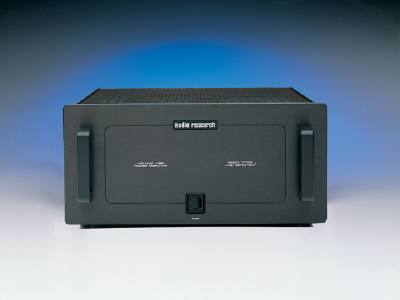
Control Functions: Power On/Off
Inputs: SE and BAL
Power Output: 100 watts per channel continuous from
20Hz to 20kHz. 1kHz total harmonic distortion typically 1% at 100
watts, below .05% at 1 watt. Approximate actual power available at
"clipping" 110 watts (1kHz). (Note that actual power output is
dependent upon both line voltage and "condition" i. e.: if power line
has high distortion, maximum power will be affected adversely, although
from a listening standpoint this is not very critical.) Power
Bandwidth: (-3dB points) 15Hz to 80kHz.
Frequency Response: (-3dB
points at 1 watt) 1Hz to 100 kHz.
Input Sensitivity: 1.9V RMS (Bal or
SE) for rated output. (23.5 dB gain into 8 ohms.)
Input Impedance: 200K
ohms Balanced, 100K ohms Single-ended. Output Taps: 8 ohms, 4 ohms.
Output Regulation: Approximately 0.8dB 8 ohm load to open circuit
(Damping factor approximately 11). Overall Negative Feedback: 10dB.
Slew Rate: 15 volts/microsecond.
Rise Time: 3 microseconds. Hum &
Noise: Less than 0.5mV RMS 95dB below rated output (IHF weighted, input shorted).
Power Supply Energy Storage: Approximately 540 joules.
Power Requirements: 105-125VAC 60Hz (210-250VAC 50Hz) 585 watts at rated output, 750 watts maximum, 380 watts at "idle".
Tubes Required: (4 ) Matched pair 6550C
Power Output: (4) 6H30 triodes.
Dimensions: 19" (48.3 cm) W x 8.75" (22.2 cm) H x 19.5" (49.5 cm) D. Handles extend 1.5" (3.8 cm) forward.
Weight: 65 lbs. (29.5 kg) Net; 83 lbs. (37.7 kg)
Shipping.
Valve amplifier (100w stereo) Bal-1, SE-1
Since the spring of 1996 the VT100 established itself as the benchmark amplifier in its price range. Accolades from the press and music lovers grew even louder with the 1998 introduction of the MKII because of its improved dynamic swing, more refined performance, and ability to drive so many "difficult" loudspeakers which normally could not be used with other vacuum-tube amplifiers.
Well, the VT100 in MKIII iteration will shake up the audio world once again and assure that it remains the best-selling vacuum tube amplifier in the world.
The advancements derived from the development of the remarkable VTM200 monoblocks have been so large that we feel compelled to integrate many of them into the VT100 through a MKIII update.
This is a major step forward in sonics, reliability, and ease of use.
Externally, the only changes are to the back panel where we have added two welcome features. There is now a Balanced/Single-Ended switch, eliminating the need for shorting links in the XLR balanced connectors when using single-ended RCA cables.
We have also incorporated a (dual in/out) 12V power on/off trigger for remote or custom installation purposes. (The soft-start surge-control feature of the VT100MKIII power circuits is preserved.) Now you can link the VT100MKIII to the LS25MKII for remote operation!
Internally, the circuitry of the VT100MKIII is derived from the VTM200.
Like its more powerful sibling, the MKIII's input stage utilizes direct-coupled JFETS for ultra low noise, and is followed by a 6H30 driver/gain stage, capacitor coupled to a 6H30 follower, driving two matched pairs of 6550C output tubes per channel.
The conservative 6H30 driver-follower circuit will help prolong the life of the 6550Cs, and the 6H30 is rated to handle higher currents than the previously used 6922, so it has lots of safety margin for even better reliability. (The 6H30 twin triode is a Russian military tube in current production, with an estimated service life of up to 10,000 hours.) There are now four internal bias adjustments-up from the previous two- to allow more accurate DC balance adjustments for the output tubes.
The line fuse has been increased to a 7 amp in 120V units (6.3 amp in high voltage units), allowing the MKIII to handle musical dynamics with greater ease.
Simply put, the VT100MKIII is a major sonic advance. As the original VT100 was greatly improved upon by the MKII, the MKIII eclipses it again by the same margin.
Resolution and dynamics are startlingly better: suddenly you can pick out each individual voice in a choir, you can hear the air gently modulated by a hundred diaphragms singing in unison in a great cathedral. Small and large details stand out in bolder relief, tightly focused,
wonderfully holographic. Bass is tighter and more dynamic. It sounds as though the power has been increased, with a more effortless quality. The MKIII is easily recognized as having been borne of the VTM200. Lastly, the single-ended RCA input is almost indistinguishable sonically from the balanced-XLR input.